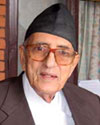The Rules of the Game

So now the big April 8 protest program being instigated, once again, by the drumbeat of the 7-party alliance, is apon us. blogdai feels there may be something different afoot this time.
Official Mascot: 7-party Alliance
Our friends in Kathmandu have told us that it is no secret that the Maoists are sending "special operatives" to the demonstration. The King has vowed a violent crack-down, and even old Girija is treating this protest as a final "mother of all protests."
It's no wonder. The King is tired of all this incessant protesting and both the Maoists and the 7-parties are broke and scavenging for support and relevance.
There is a real chance that the Parties and the Maoists won't show up if the King puts on a pre-emptive show of strength. We've seen this before. If everybody comes to the ball, however; look for a more violent affair. These ridiculous protests have worn thin and everbody would just as soon be rid of them.
Pity, all anyone had to do was sit down and talk, plain and simple. The King offered numerous chances for dialogue. The peaceful resolution of disputes is one of the first hallmarks of a functioning democracy; it looks like the parties and the Maoists would rather be rigid and go for a power grab. blogdai asks the Parties: What would it have hurt to have taken the King's invitation for dialogue? What would it have hurt to have taken part in the elections? If one thinks in democratic terms, then the answer is: nothing. If one is solely concerned about losing political power and a place at the table of corruption, then the answer is: everything.
blogdai has said it before and will say it again: NEPAL IS NOT READY FOR DEMOCRACY.
A democracy requires constant attention, maintenance and selfless sacrifice in order to thrive. The 7-party interperetation of this is to simply do whatever you want, get rich and forget about accountability. This is not democracy, this is anarchy. Democracies have rules and guidelines that preserve the safety and rights of all citizens, not just a rampaging few.
Democracy is best viewed as a team sport; a game if you will. The only way the game works is when all parties agree to play by the same rules. Does it do any good for a single party to continuously scream it's self-centered demands? No. In a real democracy you play the game to get what you want; you don't unilaterally seek to change the game in order to meet your needs. Don't like the rules of the game? Fine. Get a majority and change them through the democratic process. Protests don't work? Then find out what DOES work under the democracy game and go with it. Simply demanding that your position be adopted and boycotting, bandhing and disrupting the lives of peaceful citizens while refusing to dialogue with opposing viewpoints is about as far from democratic as one can get. In fact, it's autocratic.
We here at blogdai have recently had our own little microcosm of a 7-party tantrum. Some of our anonymous posters can tolerate neither editing nor criticism. Rather than play the democratic game and look for a rational means of expressing their views, these posters have resulted to bullying, forgery, harrassment, gross repetition, blackmail and stubborn insistence on their views in the face of clear facts to the contrary. Like a democracy, our blog has rules. We want a higher level of discourse, not a shout-fest, so we edit those posts that seek to hijack discussion space and relevance. Unfortunately, this practice has now risen to the level that blogdai now has to monitor all postings prior to their publication here. Pity again. In order to preserve the democratic pillars of our blog, we've had to resort to an undemocratic practice.
It's frustrating, but I find the parallels fascinating.
-=blogdai


